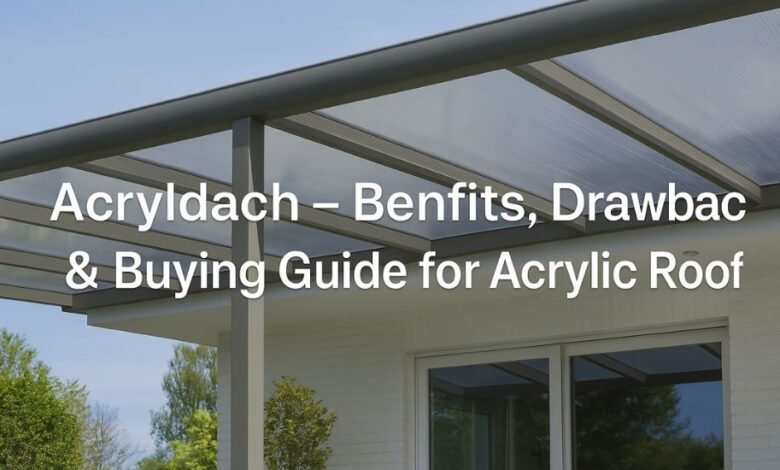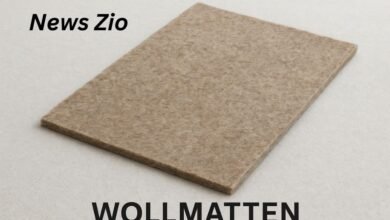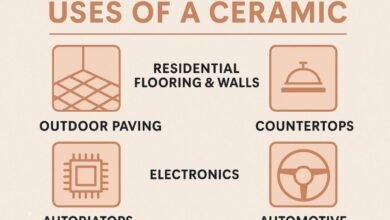Acryldach – Benefits, Drawbacks & Buying Guide for Acrylic Roofing

When planning a bright, durable, and stylish roof for a terrace, carport, or winter garden, one quickly comes across the term Acryldach. The word simply means a roof made of acrylic glass (PMMA), manufactured in the form of corrugated sheets, hollow-chamber (multiwall) boards, or solid acrylic sheets.
It is considered a modern alternative to glass: highly light-transmitting, UV-stable, lightweight, and weather resistant. But how does it compare with glass or polycarbonate? Which types are available, what are the benefits and drawbacks, and what should homeowners know before buying?
This article provides a comprehensive guide to acrylic roofing (Acryldach)—from variants and advantages to installation, maintenance, and pricing.
What is an Acryldach?
An Acryldach is a roof covering made from acrylic glass panels (also known as Plexiglas® or PMMA). These sheets are mounted onto a substructure, usually made of aluminum, steel, or wood.
Key characteristics of acrylic roofs:
-
High light transmission: up to 95%, almost as clear as real glass
-
UV resistance: quality sheets stay transparent and color-stable for 10–20 years
-
Low weight: much lighter than laminated or safety glass, easier to handle
-
Variety of forms: available as corrugated sheets, multiwall (twinwall) sheets, or solid flat sheets
This makes acrylic roofing particularly suitable for outdoor areas that require protection without sacrificing daylight.
Main Variants of Acrylic Roofs
1. Acrylic Corrugated Sheets
-
Recognizable wave profile (e.g., sinus shape 76/18)
-
Affordable and widely available
-
Easy to install thanks to overlapping edges
-
Standard thickness: ~3 mm
-
Commonly used for terraces, pergolas, garden sheds, and carports
2. Acrylic Multiwall Sheets (Twin- or Multiwall Panels)
-
Feature hollow chambers inside the sheet for extra strength
-
Usual thickness: 10–16 mm
-
Provide better thermal insulation than corrugated sheets
-
High stiffness while remaining lightweight
-
Well suited for carports, winter gardens, and premium terrace roofs
3. Solid Acrylic Sheets
-
Look almost identical to real glass
-
Extremely high clarity and elegant appearance
-
More expensive than other options
-
Require a sturdy substructure due to weight and rigidity
-
Mostly used in high-end winter gardens or modern architectural projects
Advantages of an Acrylic Roof
Why choose acrylic over other roofing materials? Here are the main benefits:
-
Maximum light transmission
An acrylic roof can transmit up to 95% of natural daylight, creating bright, welcoming spaces. -
UV protection
High-quality acrylic sheets block harmful UV rays, protecting cars, plants, furniture, and people. -
Weather resistance
Acrylic roofing withstands rain, snow, wind, and sun for decades. Many brands provide 10–20-year guarantees against yellowing and weathering. -
Lightweight & easy installation
Acrylic is much lighter than safety glass. This allows for slimmer support structures and simpler handling during installation. -
Stylish appearance
Available in clear, bronze, graphite, or milky finishes, acrylic offers a modern, glass-like look.
Disadvantages of an Acrylic Roof
Despite the many strengths, there are also some drawbacks:
-
Lower impact resistance than polycarbonate
Acrylic is rigid but more brittle. In regions prone to severe hail, polycarbonate roofing is usually safer. -
Scratch sensitivity
Acrylic scratches relatively easily. Cleaning must be done gently with soft cloths and mild soap solutions. -
Higher price than PVC or polyester
Acrylic sheets are costlier than simple plastic roofing options. -
Insulation limits
Glass or specialized polycarbonate sheets may provide superior thermal insulation.
Typical Applications
The versatility of acrylic roofing makes it popular in many settings:
-
Terrace roofing – the most common use, creating a bright outdoor living space.
-
Carports – protects vehicles from sun, rain, and snow while keeping the space light.
-
Winter gardens – clear sheets maximize daylight, though multiwall or solid sheets are recommended for insulation.
-
Pergolas, garden pavilions, sheds – lightweight and easy to install for hobby projects.
-
Commercial uses – industrial halls and warehouses often use acrylic sheets for skylights or canopies.
Installation & Mounting Tips
Proper installation is critical for durability and performance:
-
Substructure: must be stable—aluminum is recommended for its longevity.
-
Thermal expansion: acrylic expands and contracts with temperature. Leave expansion gaps and use correct mounting profiles.
-
Sealing: aluminum profiles with rubber seals prevent water ingress.
-
Accessories: closure tapes, drip edges, and matching screws should always be used.
DIY-friendly kits are widely sold, including sheets, profiles, tapes, and screws.
Care and Maintenance
To keep an acrylic roof clear and attractive for many years:
-
Clean 1–2 times per year with mild soap and lukewarm water.
-
Use soft cloths or sponges; avoid scouring agents, solvents, or abrasive brushes.
-
Remove dirt, moss, and pollen early to prevent buildup.
-
Keep the protective foil on until installation is complete to avoid scratches.
Acrylic vs. Polycarbonate vs. Glass
Choosing between these three materials depends on your priorities:
-
Acrylic: excellent light transmission, UV-resistant, elegant appearance, but more brittle and scratch-sensitive.
-
Polycarbonate: extremely impact-resistant (virtually unbreakable), strong insulation, but slightly lower light transmission and prone to yellowing over time.
-
Glass: highest scratch resistance and luxury feel, but heavy, expensive, and requires robust substructures.
Summary: Acrylic roofs are the right choice if light and style are your top priorities. For hail-prone areas, polycarbonate is the safer option. For luxury winter gardens, glass remains the premium solution.
Market Prices & Cost Factors
Prices vary depending on the type and thickness of the acrylic sheet:
-
Corrugated acrylic sheets (~3 mm): from €12–20 per m²
-
Multiwall acrylic sheets (10–16 mm): from €25–40 per m²
-
Solid acrylic sheets: €60+ per m², depending on thickness and finish
Additional costs: profiles, tapes, screws, sealing materials, and the substructure. For DIY projects, complete kits are often the best value.
Sustainability and Lifespan
Acrylic (PMMA) is recyclable and can be reprocessed into new materials. Because of its durability and long service life, it reduces replacement needs compared with cheaper plastics like PVC. For environmentally conscious homeowners, premium acrylic products are often the more sustainable option in the long term.
Conclusion
An Acryldach is a modern, stylish, and durable roofing solution for terraces, carports, winter gardens, and many other outdoor applications. It combines brightness, UV resistance, low weight, and elegant design, making it a popular alternative to glass and polycarbonate.
While it is less impact-resistant than polycarbonate and more scratch-sensitive than glass, the benefits—especially light transmission and aesthetics—make it a strong choice for private and commercial projects alike.
With proper installation and maintenance, an acrylic roof will remain a clear, attractive, and reliable cover for many years.
Note
This article was prepared for the blog project News Zio, giving readers a detailed overview of the subject of Acryldach


